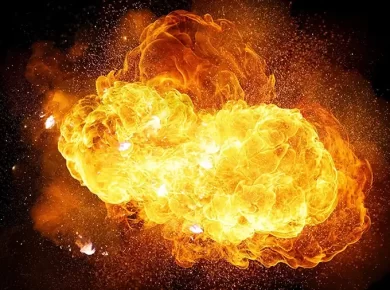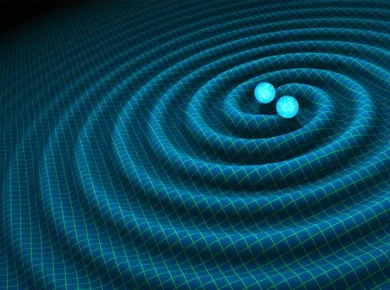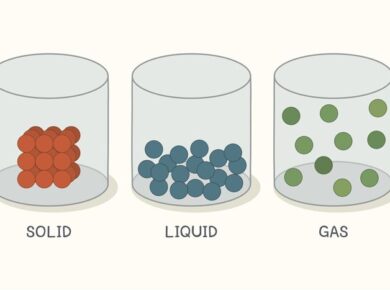Space & Astronomical Science
| 1 Light yr > 9.46 * 10^15 m | 1 AU > 1.495 * 10^11 m |
| Earth to Moon Distance > 3.84 * 10^ 8 m | Earth to Sun Distance > 1.495 * 10^11 m |
| Astronomical unit > The mean distance from the centre of the earth to the centre of the sun | |
Galaxies
Galaxies are huge collections of stars, dust and gas. They usually contain several million to over a trillion stars and can range in size from a few thousand to several hundred thousand light-years across.
- There are hundreds of billions of galaxies in the Universe.
- Galaxies come in many different sizes, shapes and brightness
- Like stars, are found alone, in pairs, or in larger groups called clusters.
- Galaxies are divided into three basic types: spiral, elliptical and irregulars.
- Our solar-system is part of galaxy called ‘Milky-Way.
Doppler Effect & Expanding Universe
- When the distance between the source and receiver of electromagnetic waves remains constant, the frequency waves is the same in both places.
- When the distance between the source and receiver of electromagnetic waves is increasing, the frequency of the received wave forms is lower than the frequency of the source wave form.
- When the distance is decreasing, the frequency of the received wave form will be higher than the source wave form.
If a body in space is “blue shifted,” its light waves are compacted and it is coming towards us. If it is “red shifted” the light waves are spread apart, and it is traveling away from us. All the stars that we have detected are “red shifted,” which is one piece of evidence for the theory that the universe is constantly expanding, perhaps from a “big bang.”
Nebula
A nebula is a cloud of gas and dust in space. Some nebulae (more than one nebula) are regions where new stars are being formed, while others are the remains of dead or dying stars.
- The word nebula comes from the Latin word for cloud
- Nebulae come in many different shapes and sizes.
There are four main types of nebulae
- Planetary nebulae
- Reflection nebulae
- Emission nebulae
- Absorption nebulae
Constellations
A constellation is a group of stars that make an imaginary shape in the night sky hence constellations are not real. They are usually named after mythological characters, people, animals and objects.
- In different parts of the world, people have made up different shapes out of the same groups of bright stars. It is like a game of connecting the dots.
- In the past creating imaginary images out of stars became useful for navigating at night and for keeping track of the seasons.
- Because all the stars are at different distances, the constellations would look totally different to inhabitants of another planet orbiting another star.
Major Constellations
- Ursa Major (Great Bear)
- Orion (Giant hunter)
- Hydra (Sea Serpent) > Largest
- Cygnus (Swan)
- Hercules
- Centaurus
Stars
- Stars are big exploding balls of gas, mostly hydrogen and helium.
- Our nearest star, the Sun, is so hot that the huge amount of hydrogen in it is undergoing a constant star-wide nuclear reaction, like in a hydrogen bomb.
- Even though it is constantly exploding in a nuclear reaction, the Sun and other stars are so large and have so much matter in them that it will take billions of years for the explosion to use all the “fuel” in the star.
- After a star runs out of fuel, it ejects much of its material back into space.
- New stars are formed from this material. So the material in stars is recycled.
Death of a star
When a star begins to exhaust its hydrogen supply, its life nears an end. The first sign of a star’s old age is a swelling and reddening of its outer regions. Such an aging, swollen star is called a red giant.
For Big stars when fuel (hydrogen) in its core runs out, it starts contracting, resulting in fusion of successive heavier nuclei like helium, carbon, oxygen etc. till a stage is reached when there is mostly iron & no more fusion takes place.
Supernova > This collapsing core imparts so much energy to the exterior of the star that it explodes with an increase in its luminosity 10000 times or even more
White dwarf > After the explosion the highly dense residual core of comparatively small star (mass upto 1.4 times our sun – Chandrashekhar limit)
The extremely dense core left after the explosion of a bigger star is called as Neuron star (mass upto 1.4 – 3 times our sun). Due to its small size, they spin very fast & radiate all kind of electromagnetic radiations. When this happens the star is known as Pulsar.
Black Holes
Still bigger stars with left core mass (after explosion) greater than 5 times the sun (most dense form) are believed to end up as black holes.
- It is extremely concentrated matter.
- The pull of gravity is so powerful that nothing, not even light, can emerge from it (hence can’t be seen)
- Black-hole formation indicates ultimate death of a star.
How Sun will End its life
The star collapses under the force of its own weight; if it is a small star, it collapses gently and remains collapsed. Such a collapsed star, at its life’s end, is called a white dwarf.
- The Sun will probably end its life in this way.
- The Sun, a middle-aged star, will probably swell to a red giant in 5 billion years, vaporizing Earth and any creatures that may be on its surface.
Solar System
- Our solar system consists of Sun + 8 Planets + 1 Dwarf planet (Pluto) + No. of Natural Satellites
- Pluto was demoted to dwarf planet at 26th general assembly of International Astronomical Union held at Czech republic in 2006
- Only sun has its own light, which is also the nearest star to the earth
| Size – Wise | Jupiter > Saturn > Uranus > Neptune > Earth > Venus >Mars > Mercury |
| Inner / Terrestrial Planets | Earth, Venus, Mars, Mercury |
| Jovian / Outer Planets | Jupiter, Saturn, Neptune, Uranus |
| No. of Satellites | Jupiter (63) > Saturn (60) > Uranus (27) > Neptune (13) > Mars (2) > Earth (1) > Venus (0) & Mercury (0) > (Moon at Jupiter were found by Galileo) |
| Time Period of revolution of Planets around the sun | Neptune > Uranus > Saturn > Jupiter > Mars > Earth > Venus > Mercury (88 days) |
- Asteroids – A belt of minor planets revolving around the sun between Mars & Jupiter
- All Planets revolve west to east around the sun except Uranus & Venus which moves east to west around the sun (Retrograde motion)
- A ray of light from sun takes about 8 mins 17 secs to reach the earth. Light takes about 1 second to reach us from the moon.
| Uranus | Maximum inclination of 98* towards the sun > known as lopsided planet |
| Earth |
|
| Mercury | No inclination at all |
| Venus |
|
| Mars |
|
| Jupiter | Distinguished from other planets by a circular light & dark bands |
| Saturn | Planet with three rings around it |
Sun
- Sun is the only star in our Solar System as it has its own source of light and energy.
- Mass of the Sun accounts to 99.86% of our Solar System.
- Its average distance from the Earth is around 149,600,000 km.
- Sunlight takes about 8 min 17 secs to reach the Earth.
- Sun’s energy is produced by constant nuclear fusion in its core through a series of processes called the p-p (proton-proton) chain. This process converts Hydrogen into Helium.
Composition of sun
- Hydrogen > 74.9%
- Helium > 23.8%
- Metals > 1.3%
Structure of Sun
The structure of the Sun can be divided into several different layers as follows:
Core
- The core of the Sun has the highest temperature and pressure among all layers.
- The temperature of the core is around 15 million degree Celsius – is in ionized state called plasma
- The solar energy is produced in the core by controlled nuclear fusion process.
- The high temperature in the core helps in removing the electrons from hydrogen atoms and in creating numerous electrons and protons for nuclear fusion.
Radiative Zone
- The Sun’s radiative zone is the section of the solar interior between the innermost core and the outer convective zone.
- In the radiative zone, energy generated by nuclear fusion in the core moves outward as electromagnetic radiation.
Convective Zone
- In this zone the density of plasma is low.
- This zone transports hot and light density fluids from the core region of high energy & temperature to the outer region of low energy & temperature.
Photosphere
- This is the first visible layer of the Sun.
- The temperature here is around 6000 degree Kelvin (5370 degree Celsius).
- The solar spots are formed on this layer. The temperature of a solar spot is around 4500 degrees.
Solar spots > Temporary dark spots formed when the magnetic field bursts through the surface. It can slow down the flow of energy from the inside of the Sun – that’s what makes the sun spots cooler & darker than the surrounding photosphere.
Chromosphere
- Chromosphere literally mean as ‘sphere of colour’.
- This layer is dominated by emission lines.
Corona
- This is the outermost layer of the Sun.
- High temperature in this region gives it an unusual spectral feature of a highly ionised ion.
- Chromosphere & corona are visible only during formation of Diamond Ring during Solar eclipse.
Some Generic Space Terms
| Asteroid | A celestial body bigger than 10 m orbiting the Sun, mainly between Mars and Jupiter Made of rock and metal, they can also contain organic compounds. Are similar to comets but do not have a visible coma (fuzzy outline and tail) like comets do |
| Meteoroid | A meteoroid is a small rock or particle of debris in our solar system. They range in size from dust to around 10 metres in diameter (larger objects are usually referred to as asteroids). |
| Meteor | A meteoroid that burns up as it passes through the Earth’s atmosphere is known as a meteor. If you’ve ever looked up at the sky at night and seen a streak of light or ‘shooting star’ what you are actually seeing is a meteor. |
| Fireball | A very bright meteor (brighter than the planet Venus). |
| Bolide | A fireball that explodes during its atmospheric flight, often with visible fragmentation. |
| Meteorite | The part of a meteoroid or asteroid that survives the passage through our atmosphere and reaches the Earth’s surface. |
| Comet | A smaller celestial body mainly composed of ice, rock and dust. As comets travel close to the Sun, some of the ice melts off and becomes a gas. This melting process causes bits of dust and debris to trail behind the comet. This tail can be seen in the night sky as a bright, quickly-moving light |
Halley’s Comet
- Halley’s Comet is arguably the most famous comet.
- It is a “periodic” comet and returns to Earth’s vicinity about every 75 years, making it possible for a human to see it twice in his or her lifetime.
- The last time it was here was in 1986, and it is projected to return in 2061.
The comet is named after English astronomer Edmond Halley, who examined reports of a comet approaching Earth in 1531, 1607 and 1682. He concluded that these three comets were actually the same comet returning over and over again, and predicted the comet would come again in 1758.
For more updates, explore the Physics. Feel free to share your thoughts and comments.
If you’re passionate about building a successful blogging website, check out this helpful guide at Coding Tag – How to Start a Successful Blog. It offers practical steps and expert tips to kickstart your blogging journey!














1 comment
thanks for the info , and dedicated research , yo’ve made my work so easy that i’m falling short of words to express my gratitude.
best wishes from my side , keep going.